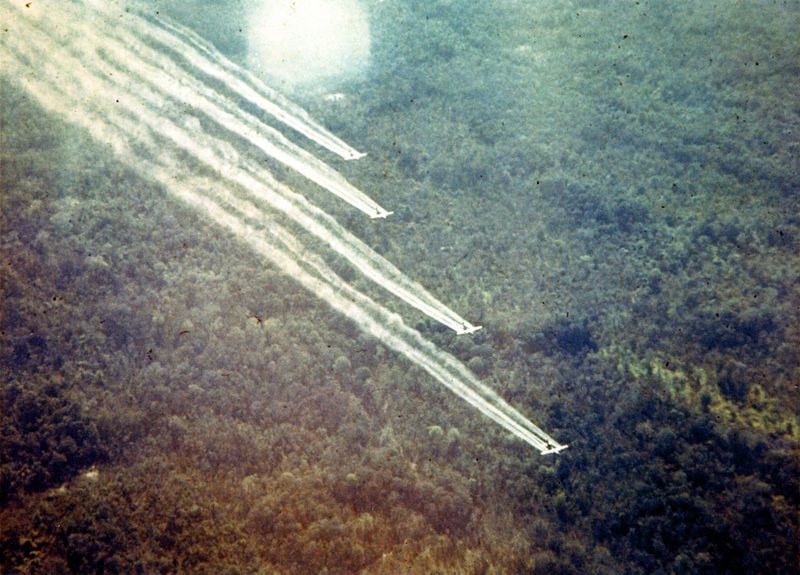Confessions of Ecocide
For years, I sprayed Tordon along Forest Service roads and up and down wilderness trails in Montana. My targets were problematic plants, usually referred to as “invasive species” and “noxious weeds.” When I worked with volunteers, I emphasized the importance of controlling these problematic plants in order to allow native plants to flourish, among other ecological benefits. Many environmental groups lauded, supported, and participated in the efforts by the Forest Service and other natural resource managers to eliminate invasive plants with the use of Tordon and other herbicides.
But environmentalists in the 1960s would have been horrified by the widespread use of Tordon. In fact, they were.
The war on weeds (action shot): Spraying orange hawkweed (Hieracium aurantiacum) with herbicide in the Scapegoat Wilderness, Montana.
My last few seasons working for the Forest Service overlapped with me beginning graduate school for history at the University of Montana. I started looking at and exploring many things through an historical lens. Aware of the way objections to pesticides had been central to the rise of the post-war environmental movement (e.g., Rachel Carson’s Silent Spring), I got interested in how many environmentalists had come to embrace the use of herbicides as a way to maintain ecological “health” or “balance” (as they saw it).
I dabbled into the history of Tordon to see how perceptions of the herbicide had changed over time. To my surprise, I found that Tordon, Dow Chemical company’s trade name for the herbicide picloram, had been one of the key chemicals used in the notorious defoliation campaign during the Vietnam War that attempted to uncover guerilla war activities and destroy food. That campaign was called Operation Ranch Hand, and the most famous chemical cocktail used during the campaign was Agent Orange.

Planes dispersing herbicides during Operation Ranch Hand, a campaign that used chemicals to defoliate trees and destroy crops during the Vietnam War. Photo: National Museum of the U.S. Air Force photo 071002-F-1234P-022.
Much has been written about the controversial human health effects of Agent Orange, a combination of the herbicides 2,4-D and 2,4,5-T. But there were other “agents” besides orange. One was Agent White, a mixture of picloram and 2,4-D (a mixture I also used for the Forest Service). Although less commonly used than Agent Orange, Agent White was considered the more powerful concoction, largely because of the inclusion of picloram, which is a highly persistent herbicide. It can last for months in the soil.
During the defoliation campaign in Vietnam, environmentalists and scientists became worried about the ecological and human effects of widespread use of powerful herbicides in Vietnam. One prominent botanist, Arthur Galston, became so concerned he invented a new term for the massive, potentially permanent effects of the Ranch Hand campaign: “ecocide” – the ecological equivalent of genocide.
Although Galston was concerned about all the herbicides used during Ranch Hand, it was picloram, with its powerful, persistent characteristics that was most worrisome to him. The dark cloud over picloram outlasted the Vietnam War, with many environmentalists and scientists concerned about its use in the United States in agriculture, forestry and in the clearing of the border between the U.S. and Canada. Concern and outrage at the use of picloram in the 1970s and after often referenced the use of the chemical in herbicidal warfare and its “ecocidal” associations.
For an earlier generation of environmentalists, my job spraying weeds with Tordon for the Forest Service was ecocidal (or at least held that potential). But by the 2000s, when I was working for the Forest Service, that attitude had changed, at least among a number of environmentalists. In my first published academic article, I set out to try to explain that change and its implications. Here is the article and links to access it:
“From Ecocide to Eco-ally: Picloram, Herbicidal Warfare, and Invasive Species, 1963-2005” (Global Environment, vol. 7, no. 1, 2014) I set out to try to explain that change and its implications.
(External Link - Paywall) (Download Preprint)
Thanks to the the Wilderness Institute’s Matthew Hansen Endowment and the Rachel Carson Center for helping support the research and development of this article.
